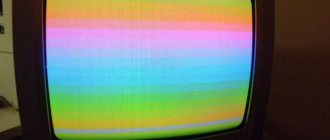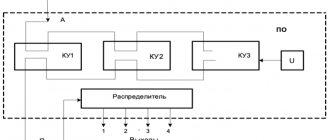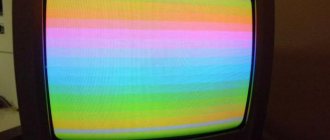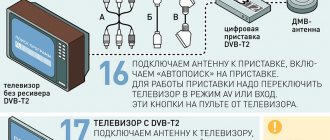Of course, these two terms will seem familiar to you on TVs and game consoles of yesteryear, where many times even the latter included some kind of adapter that had to be connected to the TV in order to be able to choose whether we wanted the signal to be one. type or other. However, it goes much further, and then we will tell you all about it, including its impact on the modern world.
Contents [show]
- Definition of NTSC and PAL
- Introduction to Analog CRT Displays
- History of NTSC
- History of PAL coding
- NTSC and PAL in the gaming world
What is NTSC?
So, many American video recording media are in NTSC format. What it is? Today it is the color encoding system used by DVD players. Until recently, it was used by broadcast television in North America, Japan and much of South America.
As color televisions began to replace black-and-white televisions, developers began using several different methods to encode color for broadcast. However, these methods conflicted with each other and with old black-and-white televisions, which could not interpret the color signals transmitted to them. In 1953, the US National Television System Committee adopted the NTSC standard, which was developed and implemented as a single standard. From that moment on, it could be used throughout the country, as it became compatible with a large number of different TVs. Nowadays you can still find NTSC. What does it mean? Even though modern TVs no longer use this format, they can still receive and recognize it.
Difference of standards
PAL SECAM NTSC what is it? Each color rendering system offers a number of characteristics that affect compatibility and pairing:
- NTSC uses 525 lines of picture with a storyboard of 30 FPS. This need is due to the parameters of the US power grid - 230V and 60 Hz. The predominant colors are red and blue.
- PAL and SECAM work on the ATB color standard, which has 625 lines per frame. It is noteworthy that all of Europe uses 25 FPS, which are tied to the properties of the electrical network - 220V and 50 Hz. The main colors are red, green, blue.
The two video standards PAL and SECAM are compatible, but the standard differs significantly from NTSC, since the latter technically involves fewer cathode ray tubes transmitting primary color signals.
There were cases in the early 90s when color TVs displayed a black and white picture, due to:
- By watching analog TV on a recently purchased Japanese-made TV that only works with NTSC, which does not work in Europe and the post-Soviet countries.
- Watching video from cassettes on which the video track was recorded using the NTSC standard. As a result, this color rendition was not recognized by videocassette players in the USSR and Europe.
To eliminate this problem, it was necessary to additionally purchase a decoder and integrate it into the board of the picture playback device.
If you have a choice of PAL or NTSC, then definitely choose PAL to watch the remaining ATV in Russia.
What is PAL format?
Before you decide which is better - PAL or NTSC, you need to understand how they differ from each other.
The PAL format is a color encoding system used by DVD players and broadcast television in Europe, much of Asia and Oceania, Africa and parts of South America.
Phase Alternating Line or PAL formatting, along with the SECAM standard (previously used in Russia and the CIS, the image in this method is translated as sequential color with memory), was developed in the late 1950s to circumvent certain shortcomings of the NTSC system.
Because NTSC encodes color, it means the signal can lose clarity in poor conditions, so early systems built on this format were vulnerable to bad weather, large buildings, and several other factors. To solve this problem, the PAL video format was created. It works as follows: during broadcast, it changes every second line in the signal, effectively eliminating errors.
Unlike NTSC, PAL is still often used for over-the-air broadcasting in the regions in which it was adopted.
Basic moments
- The color rendering system is the output of a color image using the interlaced method. Several standards for such systems are used in the world - NTSC, PAL and SECAM. Each standard operates on a single technology, provides the overlay of 3 primary colors (red, green, blue) and transmits them using cathode ray tubes.
- The color rendering standard is a technology implemented for image output, and not for broadcasting. It is used for analogue television broadcasting and color film editing.
- The NTSC standard was first adopted in the USA. Then it spread to Japan. 14 years later, France introduced its SECAM system, which was adopted by the Soviet Union. And Europe in the same year standardized PAL, which was introduced by Germany.
- In the 1990s, the Russian Federation and the CIS countries, together with SECAM, implemented PAL, which resulted in problems for some owners of old TVs. To solve the problem, a soldered SECAM/PAL decoder was needed. To Pal Sekam's question, it can be answered this way - it is a decoder for implementing compatibility between two technologies, which smoothly migrated into a single PAL standard.
PAL or NTSC: which is better to use?
Many video editing programs, such as VideoStudio, allow you to choose what format to save your work in when burning to DVD.
Which format you should use mainly depends on your location. If you are creating videos that will be displayed around the world, NTSC by choice is safer and more comfortable. Most DVD players and other PAL-based devices can play NTSC video, but NTSC-based players usually do not support PAL.
Some new TVs do not have analog ports
If you bought a TV in the last year, you may have noticed that it has a few HDMI ports, perhaps a DisplayPort, but lacks the colorful RCA ports you're used to. Analog video is finally dying.
This solves the NTSC/PAL compatibility issue by eliminating the ability to use older video sources with newer TVs.
In the future, you may need to buy an NTSC/PAL compatible HDMI converter. Again, they are quite expensive now. However, once demand increases, they should cost less.
Why are these formats still used?
The basic answer is that they are not today what they were originally created to be. It is clear that the technical problems that these coding systems were created to solve in the 1950s do not apply to the modern world. However, DVDs are still labeled as supporting NTSC or PAL (see above for which one to buy and why), and the timings, resolutions, and refresh rates set in these systems are still used in modern TVs and monitors.
The main reason for this is the regionalization of content. The use of different video formats acts as a layer of physical protection to strengthen national copyright laws, and prevent the distribution of films and television programs in different countries without permission. In fact, this is the use of formats as a legal method of copyright protection. This phenomenon is so common that distribution regions for video games and other interactive electronic media are often referred to as NTSC and PAL regions, although such software works fine on any type of display.
Further use
The considered color rendering system was used in broadcast, satellite, cable television and for recording on media until the advent of technology for encoding information into a digital format. This has led to the ability to store and transmit more information. CDs replaced magnetic tapes and floppy disks, and digital and interactive television replaced ATV.
In digital technology, the image is displayed separately from the sound in mpeg-4 format and the use of color transmission in the NTSC, PAL, SECAM standards is completely discontinued. Nowadays they can only be found when editing videos for subsequent broadcast in the usual form or recording on magnetic tape.
(votes: 2 , average rating: 4.50 out of 5)
PAL, NTSC formats: what is the difference from the technical side?
Televisions display their images line by line and create the illusion of movement by displaying them slightly altered, many times per second. The broadcast signal for black and white television simply indicated the brightness level at each point along a line, so each frame was simply a signal with brightness information for each line.
Initially, televisions displayed 30 frames per second (FPS). However, when color was added to widescreen broadcasts, black-and-white TVs could not distinguish color information from luminance information, so they attempted to display the color signal as part of the picture. As a result, it became meaningless, and the need arose to introduce a new TV standard.
To display color without this problem, the broadcast needed to add a second chrominance signal between the luminance signal fluctuations, which would become ignored by black-and-white TVs, and color devices would look for it and display it using an adapter called a Colorplexer.
Because this extra signal was added between each frame update, it increased the amount of time it took for them to change, and the actual FPS on the display was reduced. Therefore, NTSC TV plays 29.97 frames per second instead of 30.
In turn, a PAL signal uses 625 lines, of which 576 (known as a 576i signal) appear as visible lines on the TV, while a formatted NTSC signal uses 525 lines, of which 480 appear visible (480i). In PAL video, every second line has a phase change in the color signal, which causes them to equalize the frequency between the lines.
Main characteristics of the NTSC format
The horizontal scanning frequency for NTSC M is 525 lines per screen, the frame rate is 30. The frequency band occupied by the video signal is 4.2 MHz. NTSC N uses slightly more lines - 625 and a lower frame rate - 25 Hz.
NTSC based system
allows you to provide high quality color images, but imposes very stringent requirements on receiving and transmitting equipment. Due to the peculiarities of signal formation in this format, during decoding it is not always possible to completely separate the signal into individual components, so color signals are mixed with brightness. And, depending on the brightness of the image area, it may slightly change its color tone.
Phase distortions of the signal, which sometimes occur during transmission, also contribute to a not entirely natural transmission of color tone, and amplitude-frequency distortions cause a change in color saturation.
PAL standard
(eng.
Phase Alternation Line
) was first used in 1967 in Germany and the UK. Broadcasting in these countries began in slightly different versions, which have now become even more numerous. PAL is widely used in most countries in Western Europe, Africa, Asia, Australia and New Zealand.
Essentially PAL
is an advanced NTSC system that eliminates the sensitivity of the transmitted signal to phase distortion by changing the method of modulating the color carrier frequency. True, this led to some deterioration in clarity, which is partly compensated (in some versions of the standard) by an increased number of lines.
The PAL standard has the largest number of used varieties.
SECAM standard
(French:
Sequential Couleur Avec Memoire
) - sequential color transmission with memory was developed in France.
Regular broadcasting using it began in 1967, in France and the USSR. SECAM
uses 625 lines at 25 frames, or 50 fields per second
. SECAM
now used in France and some European countries, some former CCCP countries and Africa.
The peculiarity of the system is that color difference signals are transmitted via frequency modulation. Whereas PAL and NTSC use quadrature amplitude modulation. Frequency modulation, as well as alternate (through the line) transmission of two color signals, made it possible to get rid of excessive sensitivity to distortion, but somewhat deteriorated the clarity, which, however, is not always fundamental in the conditions of receiving terrestrial television and is most noticeable in cable systems. SECAM
allows you to achieve more natural color rendering due to improved separation of color signals from brightness.
For recording on magnetic tape, a version of the standard was used - MESECAM
, in which the color difference subcarriers are moved to lower frequencies (approximately 1.1 MHz), which minimizes the impact of tape speed variability on color quality.
A list of the main differences between the standards is summarized in the table. As can be seen, there are significant differences in carrier frequencies and the total frequency band occupied in communication channels.
| Standard | NTSC M | PAL B,G,H | PAL I | PAL N | PAL M | SECAM B,G,H | SECAM D,K,L |
| Number of lines/frames | 525/30 | 625/25 | 625/25 | 625/25 | 525/30 | 625/25 | 625/25 |
| Video signal frequency band, MHz | 4,2 | 5 | 5,5 | 4,2 | 4,2 | 5 | 6 |
| Color carrier, MHz | 3,58 | 4,43 | 4,43 | 3,58 | 3,58 | 4.25 and 4.406 | 4.25 and 4.406 |
| Sound carrier, MHz | 4,5 | 5,5 | 6 | 4,5 | 4,5 | 5,5 | 6,5 |
However, today it is unlikely that readers will have to suffer seriously due to problems and incompatible formats. No matter how you output video from your computer, you will almost always have a choice of at least two PAL
or
NTSC
.
PAL, SECAM and NTSC
– these are systems in which a signal is broadcast from an antenna, cable receiver, satellite receiver or DVD.
PAL, SECAM and NTSC
- These are systems of color or color transmission.
If they are incompatible between the signal source and the TV, the picture on the screen will be black and white, or may be narrowed or striped without a standard image. The signal itself, which the TV circuit processes, contains information about brightness
and
color
. Color information is encoded into one of the systems PAL, SECAM...
To get a color image, just three colors are enough: red
,
blue
and
green
. Therefore, the television signal must contain information about these three colors and the
brightness
.
Knowing information about brightness Y
, as well as the signal of
B
and red
R
, through a simple calculation, find out information about the green color
G.
- NTSC
As signals for transmitting color information in the system
NTSC
accepted
color difference signals
(
R.Y.
And
BY
). The transmission of these signals is carried out in the spectrum of the brightness signal at one color subcarrier frequency, with a phase shift of
90 degrees.
There are several standards NTSC, the most popular of which are:
NTSC4.43
and
NTSC 3.58
.
They all have a half-frame frequency of 60Hz
(more precisely: 59.94005994Hz), number of lines:
525
(486 active), and numbers:
4.43
or
3.58
- this is the frequency at which color information is transmitted (modulation frequency)The main disadvantage of the system is the possibility of distortions in color reproduction. They cause a change in the color tone on the TV screen depending on the brightness of a given area of the image. For example, human faces on a screen appear reddish in the shadows and greenish in highlights. To reduce this distortion, NTSC
equipped with color tone regulators:
TINT CONTROL
. This control allows you to achieve a more natural coloring of details with a certain brightness, but the distortion of the color tone of the brighter or darker areas of the image even increases. - PALPAL
- an analog color television system, developed by an engineer from a German company and presented as a television broadcasting standard. System
PAL
is the main color television system in Europe.Main characteristics: half-frame frequency – 50Hz
,number of lines –
625
(576 active), modulation frequency of the color subcarrier (color information)
4.43 MHz
Since the number of full frames in PALequals
25
(per second) - this is close to
24
standard filming frames, therefore, the process of transferring film films to the PAL television standard is as simple and convenient as possible (no need to trick extra non-existent frames, as for NTSC)Adding the voltage at the input of the delay line with the inverted voltage at its output eliminates the phase error (failure) and the color gamut on the TV screen looks more natural than when watching programs encoded in NTSC.
the PAL-60 standard
, supports the 60Hz field change frequency adopted in the NTSC system, so it can work on equipment and televisions that have this frame rate.
- SECAM
The main advantage of the system
SECAM
is the absence of cross-distortion between color difference signals, achieved through their sequential transmission. However, in practice, this advantage may not always be realized due to the imperfection of the color signal switches in the decoding device. System
SECAM
practically insensitive to differential phase distortions, especially critical for the NTSC system. Due to the use of frequency modulation, there is high resistance to changes in the amplitude of the subcarrier that arise due to the unevenness of the phase-frequency response of the transmission path. The NTSC system is more sensitive to such distortion, which manifests itself as a change in color saturation. For the same reasons
SECAM
less sensitive to variations in video tape speed.SECAM standard are used around the world.
, which do not differ from each other in the way they transmit color difference signals, including so-called pre-emphasis.
Only the carrier frequencies of the brightness video signal, audio and the method of sound modulation differ. One of the important differences nowadays is the method of color recognition. SECAM
color recognition signals and subcarrier pulse packets during line blanking can be used. - MESECAM MESECAM
is a type of the
SECAM
and serves to ensure that VCRs operating in the PAL standard have the ability to record programs broadcast in the SECAM system. It was not the best, but a fairly simple and inexpensive development, the need for which arose with the massive distribution of VCRs in the countries of Eastern Europe (USSR) and Asia, which received television signals in the SECAM system - HDTV HDTV (High Definition Television)
is a new direction in the development of television in the world.
The name in Russian is high-definition television (HDTV)
.
Conventional television requires an image resolution of 720 by 576 pixels, while HDTV allows you to watch television programs with a resolution of up to 1920 by 1080 pixels. So the HDTV
5 times more than in regular television, or we can say that
HDTV
is five times clearer than regular TV.
Another feature of the HDTV
is that it regulates 60 progressive frames per second, while conventional TV only provides 24 (25) frames per second. This number of frames allows you to get a much softer and more natural image on the screen, especially in dynamic scenes.
The term “High Definition” appeared in the 30s of the 20th century. It was then that a qualitative leap occurred in television: systems began to be used that made it possible to abandon images with a resolution of 15 - 200 lines. In the mid-50s, the first prototypes were created. However, in order for high-definition television to become visible to the naked eye, a display with a large screen diagonal is required. The high cost of such displays hindered the development of HDTV
for decades.
The rapid development of HDTV
began in the mid-2000s, simultaneously with the widespread use of plasma and liquid crystal displays.
· 720p: 1280×720 pixels, progressive scan, aspect ratio 16:9, frequency - 24, 25, 30, 50 or 60 frames per second (this HDTV format is recommended as standard for EBU member countries);
· 1080i: 1920×1080 pixels, interlaced scanning, aspect ratio 16:9, frequency - 50 or 60 fields per second;
· 1080p: 1920x1080 pixels, progressive scan, 16:9 aspect ratio, 24, 25 or 30 frames per second.
To watch HDTV
movies you need
an HDTV
TV. This can be
an HDTV
plasma, LCD TV or
an HDTV
projector.
You can also watch it on a monitor (LCD or CRT), but
you won’t see
HDTV You also need a player with HDTV
, or a powerful computer.
If you want to enjoy HDTV
television at home, you need to purchase a special receiver and satellite antenna.
PAL, SECAM and NTSC
– these are systems in which a signal is broadcast (from an antenna, cable, satellite receiver or DVD). The most important thing you need to know about them and a little history in our article
About what PAL
or
SECAM,
most of us learned only in the late 80s, when we brought with us from abroad or bought the first imported video recorders, video players and video cassettes with films or music in company stores.
What a disappointment it was when it turned out that it was not so easy to connect them to our Soviet televisions, and having connected them, it turned out that the picture was black and white. Then, turning to the master, the owner of the “video” learned that his television only received the system “ SECAM
” colors, and all the videotapes he bought were recorded in “
PAL
” or, even worse, in one of the “
NTSC
”
In simple terms, PAL, SECAM and NTSC
- These are systems of “chromaticity” or color transmission.
If they do not match (at the signal source and the TV), the picture on the screen will be black and white (and it may also be narrowed or even stripes instead of a picture). The signal itself, which the TV circuit processes, contains information about brightness
(black and white picture) and
color
(how the black and white picture should be colored). So, information about the color of “paints” is precisely encoded into one of the PAL, SECAM systems...
When confirm the order, we will ask customers what TV system in their country is: NTSC or PAL. This was requested. Then, What is NTSC, PAL?
PAL, NTSC, and SECAM, the three TV technology standards of the analogue color world. This standard is for television station and television to carry video and audio signal together. Only by maintaining the same technical standards can it be possible to achieve a television signal of normal reception. It's the same as sockets and plugs, only the same type can be connected together. The China plug cannot be inserted into a UK standard power socket.
Color display The image on a TV screen consists of a mixed signal of three primary colors: red, green and blue. The brightness level of the three colors makes colorful images. How to deal with the three main color signals and achieve broadcasting and reception, this requires certain technical standards that formed the color television standard. So comes three TV systems: NTSC (also known as the N system, or US standard), PAL system (also known as Parr or West German, UK), SECAM system (also known as the Sekon system or French system). The main differences between these three systems are frame rate (field frequency), resolution rate, signal and carrier bandwidth, color space conversion ratio, etc.
PAL (Phase Alternating Line), a television system developed in 1965, is mainly used in China, Hong Kong, the Middle East and Europe. This system is with 4.43Mh color bandwidth, 6.5MHz audio bandwidth, 25 frames per second.
NTSC (National Television Commission) standard is developed from the National Television and Radio Committee of the United States in 1952. The United States, Canada, Japan, China Taiwan, South Korea, the Philippines and other countries use this standard. This system with 3.58Mhz color bandwidth, 6.0Mhz audio bandwidth, 30fps image.
Why is the NTSC system 30 frames per second while the PAL system is 25 frames per second? This is because the country's electricity is 110V\60Hz, so the frequency of the TV field signal directly receives the AC frequency of 60Hz, and two represent the frame, so 60 divided by 2 is equal to 30, which is the number of television frames. China's electricity is 220V\50Hz, so 25 per second.
What does it mean?
In terms of effect, this means that signal corruption appears as a saturation (color level) error rather than a tint (color tone) error, as it would in NTSC video. This resulted in a more highly accurate picture of the original image. However, the PAL signal loses some vertical color resolution, making colors at line junctions appear a bit washed out, although this effect is not visible to the naked human eye. On modern DVDs, the signal is no longer encoded based on connecting lines, so there are no frequency or phase differences between the two formats.
The only real difference is the resolution and frame rate at which the video is played.
PAL and NTSC on HDTVs
Television has a broad analogue system, so while digital signals and high definition (HD) are becoming a universal standard, variations remain. The primary visual difference between NTSC and PAL systems for HDTV is the refresh rate. NTSC refreshes the screen 30 times per second, while PAL systems refresh the screen 25 frames per second. For some types of content, especially high-resolution images (such as those generated by 3D animation), HDTVs using the PAL system may exhibit a slight tendency to "flicker". However, the picture quality is NTSC and most people won't notice any problems.
On a DVD signal, the signal is not encoded based on the carrier wave, so there are no frequency or phase differences between the two formats. The only real difference is the resolution and frame rate (25 or 30) at which the video is played.
Part 2. Comparison table NTSC VS PAL
As for the main differences between NTSC and PAL, there must be a difference in color coding. The PAL standard controls color automatically, which uses an alternating phase of the color signal that removes hue errors. NTSC, compared to PAL, has manual tint control for color correction. That is, if colors are inactive, the higher saturation of the NTSC system makes them more noticeable and adjustable. For other differences, you can find out more details from the comparison chart.










